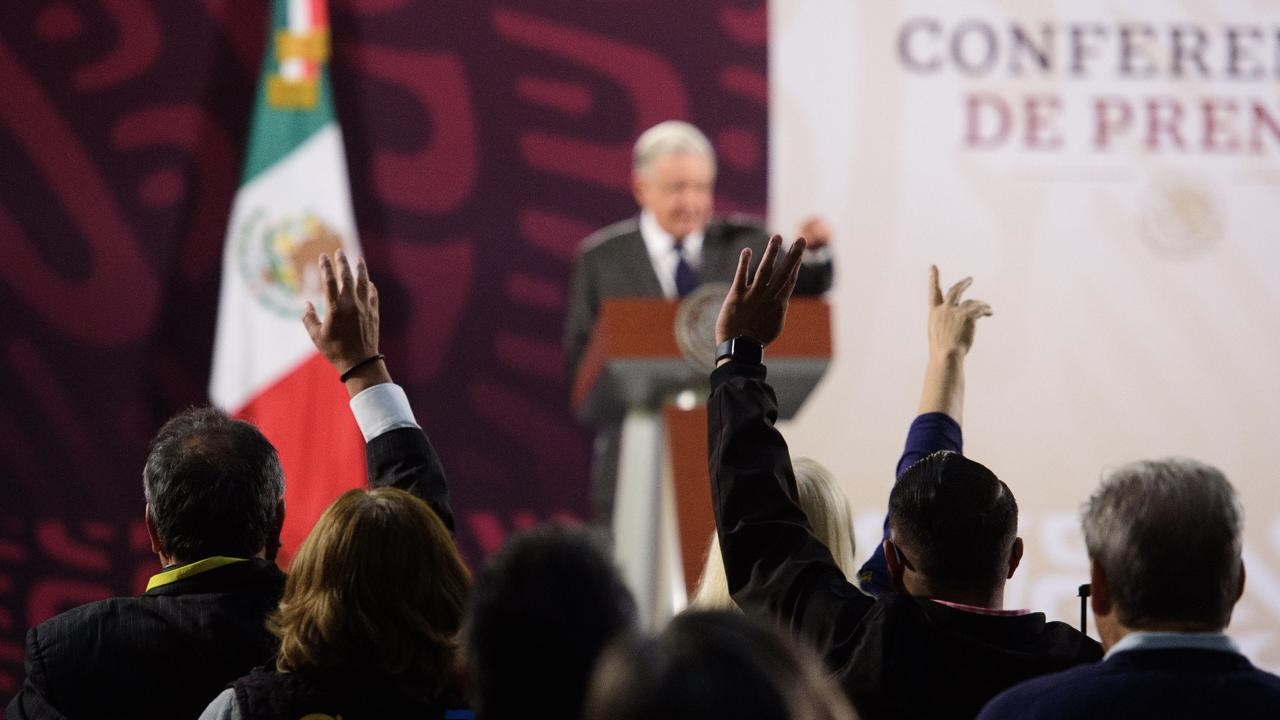The reform, which has caused significant resistance from the right, proposes the election by popular vote of all judges, the separation of responsibilities of the Judiciary Council, and the establishment of new rules for judicial proceedings

AMLO addressing the press in his daily press conference on July 10. Photo: Presidencia MX
Since the beginning of 2024, the government of Andrés Manuel López Obrador (AMLO) has promoted a set of legal reforms aimed at transforming Mexico’s judicial system. These reforms are in addition to 20 others that the government of MORENA has sought to approve since February 2024. AMLO’s proposal rests on four fundamental pillars.
- Popular vote to elect judges
The first pillar is the government’s proposal to elect judges and magistrates by popular vote as of 2025. Candidates will be proposed by the three branches of government and will not be able to use public or private financing to promote their campaigns, except through time allocated equally on television and radio. In addition, political parties are prohibited from campaigning for or against these candidates. If there is no candidate, the Senate will have the obligation to elect an interim person in charge until the next election is held.
This has probably been the most contested measure of judicial reform. Some legal scholars have criticized this measure saying that the election by vote would infringe upon a judge’s ability to decide cases fairly and instead would push them to rule in order to win votes.
AMLO defends the proposal because, according to him, Mexican judges are currently too powerful. “[Judges] have too much power, too much. There is no control or counterweight [to their power].” In addition, the Mexican president affirms that, in the face of the corruption present in the judicial system, what is needed is a replacement that starts from the very foundations of the system. “How does one confront decadence? Well, with a process of true change from the root [of the judicial system]… And who can do it? The people!” stated AMLO.
Currently, few countries elect some judges by popular vote, such as the United States, Bolivia, and Switzerland, but, if this point of the judicial reform is approved, Mexico would be the only country that would elect all of its judges through this mechanism.
- Replacement of Judiciary Council
The second pillar of judicial reform consists of the replacement of the Judiciary Council by two institutions: the Judicial Discipline Tribunal and the Judicial Administration Body. While the Judicial Disciplinary Tribunal will be in charge of administrative functions, regulation of internal processes, and the elaboration of the judiciary’s budget, the Judicial Administration Body, which would be integrated by five people, will be in charge of receiving complaints and investigating magistrates of the supreme court, judges and other persons linked to the judiciary who carry out illegal acts. AMLO hopes, through this reform, to expedite the processes that today the Judiciary Council is unable to process in time, as well as to establish differentiated functions to reduce the power now held by only seven members. - Shorter terms for Supreme Court justices
The third pillar of the reform consists of reducing the number of members of the Supreme Court and shortening their term of office. If the proposal is approved as it stands, instead of 11 members, the Supreme Court will be composed of 9. In addition, the term in office would no longer be 15 years, but 12. It is also intended that all sessions of the plenary of the Supreme Court be public and not private, as well as the elimination of the life pension for current and future members. In addition, it is intended that the monthly salary of these officials will not exceed the salary of the President of the Republic, which is around USD 8,000.
According to Ana Elízabeth García, one of the spokespersons for AMLO’s government, this is one of the measures that has caused the most resistance and has provoked a media campaign that seeks to discredit the judicial reform: “The [high] salaries of the judiciary may be the reason why the oligarchs oppose the [judicial] reform… Perhaps what bothers these high judiciary officials the most is that they feel they are losing a ‘gold mine.’”
- New rules for proceedings
The fourth pillar of the judicial reform consists of the establishment of new rules for judicial proceedings, such as establishing a maximum term of six months for the resolution of tax matters and one year for criminal proceedings; the prohibition of “suspensions against the effects of laws in protections, constitutional controversies, and unconstitutional actions”; among other rules.
Support and resistance to the judicial reform
The president-elect, Claudia Sheinbaum, supports the proposal, although she asked the current president to include different opinions from various social sectors so that the reforms are massively supported: “In the case of the reform to the Judicial Branch, [I asked President AMLO that] not only the Permanent Commission [discuss the reform] but also the lawyers’ associations, the law schools, the ministers and magistrates themselves; obviously, [also] the workers of the Judicial Branch. There must be a broad discussion in these months so that it is known, for example, how many district judges there are; few people know how many district judges there are in the federal country, how many magistrates, etc. Let the reform that was sent be known and let this discussion be opened. And we both agreed that it should be so.”
However, the road to the establishment of judicial reform will not be easy for MORENA. On July 8, the Democratic Initiative of Spain and the Americas (IDEA), which groups several right-wing former presidents, expressed their rejection of the measure: “We strongly reject any attempt to modify the judicial system that could weaken the independence and autonomy of judges, magistrates, and ministers of the Mexican Judiciary, including the Electoral Tribunal; such as the proposal of the official Morena party, which seeks to implement popular elections for the selection of these positions, making them dependent on political influences, compromising the impartiality of their ministries and making them prey to a Justice of opinion.”
The Mexican Senate rejected the statement. According to Edgardo Palacio Diaz, Secretary of the Board of the Chamber of Deputies: “We categorically reject the statement on the Reform of the Mexican Judiciary issued by IDEA and signed by several former presidents identified with a right-wing ideology as an attempt against the sovereignty and self-determination of the Mexican people, and for being an unacceptable act of interference in the internal affairs of our nation.”
In addition to external pressure, several judges and magistrates in Guanajuato said that if the judicial reform is approved, they will declare an indefinite strike. “This first act of civil resistance will escalate,” said Ariel Alberto Rojas, Magistrate of Mexico.
Thus, AMLO and Sheinbaum will not only have to take into account the votes in the Legislative to implement the reform, but they will also have to circumvent an important section of the complex and powerful institutional framework that resists the judicial change proposed by MORENA
Source: People’s Dispach












